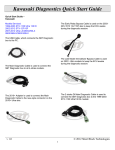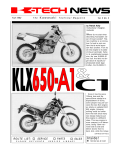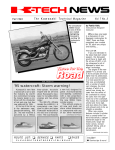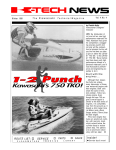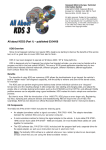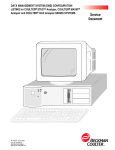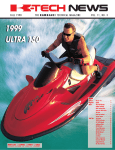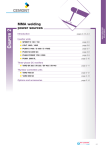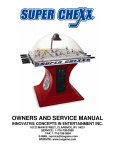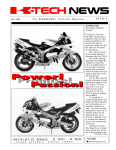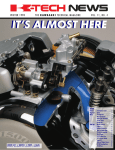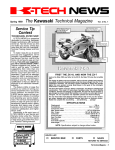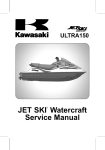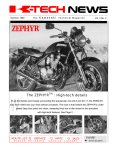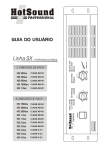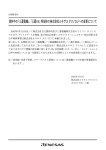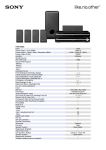Download Ultra® Pro Service - The Motorcycle Project!
Transcript
Instructor Lesson Plan 2014 Ultra® Pro Service Service Training and Communications Kawasaki Motors Corp., U.S.A. Ultra® Pro Service Technical Training Kawasaki Ultra® Pro Service Tools and Materials Lesson Tool / Item Part No./Backup Finding TDC TDC finder 57001-402 Diagnosing Mis-Timed Cams Jumper wires Radio Shack, tackle box Ultra X Exhaust Filters Diffusers Supercharger Belt Tens Early tensioning tool 57001-1697 Later tensioning tool 13280-0726 Replacement eng mnt 92161-3789 Wrench extension 08-0134 24” long ½” dr extens WBB993361 Replacing S/C Belt ½” to 3/8” reducer 2x4 Inspecting/Removing Pump Impeller Removing Pump Shaft Impeller vise holder 57001-1695 Impeller wrench 57001-1228 Bearing driver set Sunex Later model 3-bear shaft Pump Reasembly/Reinstall Old pump shaft 13107-3788 New pump shaft 13107-0764 New pump bearing 92045-3744 x2 New pump bearing 92045-3745 Snap ring 92033-3730 Oil seal 92049-3739 x3 Nut 92015-1512 Oil seal 92093-3749 o-ring 92055-3741 o-ring 92055-3744 1 3 Ultra® Pro Service Technical Training Ultra Key Registration KDS Diagnostics o-ring 93055-1101 o-ring 92055-0183 o-ring 92055-025 Spare keys 27008-3767, tackle box Registration tool 57001-1582 2010 and later cable 57001-1746 KDS kit and laptop PWC relay cable Lab Activity Fog S/C Fogging aerosol General General supplies 2 57001-1696 See training center assets list Hands‐On TTraining 2014 4 Technica al Training g Sign‐In Sheet On Course:: Kawasaki Hands‐O n: Location print clearlly, name/d dealer num mber Please p D Date: Instructtor: Please copy this sheet for e each class instructed d. Hands-On Training 2014 Technical Training Instructor Notes Course objectives • Demonstrate (throught written assessment) knowledge of MuleTM product, including service bulletins • Bleed a MuleTM cooling system • Time a diesel MuleTM fuel injection pump • Perform basic maintenance checks on a MuleTM CVT system • Demonstrate (through written assessment) understanding of operation of MuleTM CVT system • Disassemble, inspect and reassemble a MuleTM CVT system • Demonstrate competency in performing basic engine diagnostics • Use the MuleTM built-in self-diagnostics to retrieve fault codes • Use KDS3 to retrieve MuleTM fault codes Course ethic and thrust • There is plenty of time to do things in various ways. Draw pictures, talk, demonstrate – it is up to you. • Your lecture/discussion should be grounded on K-Dealer and the official service manual online. Use both, and have both open, during class discussions. • No service bulletins are included in the student workbook so the student is encouraged to look the bulletins up in K-Dealer. Online use • I recommend you have at least one (loaner?) laptop at the student’s disposal so they can look up service bulletins. We want to model this for our students. • We also want to model how the efficient shop uses K-Dealer. The lesson plan • This lesson plan is not scripted, it is merely a skeleton framework around the student objectives. You the instructor put the flesh on the content by bringing your background, experience and unique perspective to the subject. Focus on the objectives. • Pieces of the student workbook are included in the lesson plan for your convenience. • The final quiz is also included in the lesson plan. The student workbook • The student workbook is half notepages and half resources. • A workstation check-off sheet is provided for the student also. Taking attendance • You have three choices: Do it online, the most efficient way • Or use the student namecards inside the students’ workbooks • Or use the traditional one-sheet sign-in sheet – be sure to label with course and date Course quiz • The course is designed to have the students take the quiz in class before they leave Day 1 FINDING TRUE TDC 20 MIN DIAGNOSING MIS‐TIMED CAMS 15 MIN SPARK PLUG REPL TIPS 15 MIN LAB 75 MIN Day 2 REMOVING PUMP IMPELLER 15 MIN REPL PUMP BEARINGS 15 MIN REASSEMBLING PUMP 15 LAB 120 MIN Day 3 TAKING OUT OF STORAGE 15 MIN LAB 90 MIN LUNCH BREAK 60 MIN DEBRIEF 15 MIN Day 1 INTRO 15 MIN ULTRA HISTORY 15 MIN ULTRA SERVICE BULLETINS 30 MIN AM BREAK 15 MIN Day 2 DEBRIEF 15 MIN INSPECT JET PUMP IMPELLER 15 MIN INSPECT JET PUMP CASE 15 MIN INPSECT PUMP BEAR & SEALS 15 MIN Day 3 DEBRIEF 15 MIN SVCING SUBMERGED PWC 45 MIN PREP FOR STORAGE 30 MIN AM BREAK 15 MIN END OF COURSE FINAL QUIZ 20 MIN Day 3 MAKING A SHOP KEY 15 MIN ULTRA KEY REGSITRATION 30 MIN DEBRIEF 15 MIN LUNCH BREAK 60 MIN Day 2 250/260 S/C BELT TENS 10 MIN SUPERCHG PWC EXH FILTERS 10 MIN DEBRIEF 15 MIN LUNCH BREAK 60 MIN Day 1 Kawasaki Ultra® Pro Service Course Map END OF DAY 2 LAB 90 MIN KDS DIAGNOSTICS 30 MIN ONBOARD DIAGNOSTICS 30 MIN Day 2 END OF DAY 1 LAB 120 MIN REPLACING THE S/C BELT 15 MIN Day 1 Ultra® Pro Service Technical Training Enrolling student(s) User Browser Find user(s) Checkmark user(s)‐‐>select "Actions" Select "Training Registration" Find course Click "Review and Confirm" Find location, scroll down, click"Perform" Click "Done" Marking student(s) attended Registration browser Find your section way down at the bottom Make New Status "Complete" Click "Perform" Filter by Course Section Click "Actions" tab, checkmark students, select "Edit Status" Choose completion date, click "Review and Confirm" Click "Done" Ultra 300 Pro Service Technical Training Ultra 300 Pro Service Introduction Ref Lesson Objectives The student will: 1. Learn and anticipate the direction and scope of the course 2. Be informed of the location of the restrooms and fire extinguisers Notes Benefit to the Student The introduction will “break the ice” and prepare the student to get into the mood to learn. It sets the tone, perspective, and pace of the course. It also allows late-comers time to arrive and not miss too much core material. Lesson LIVE OL DAY 1 A. Introduction 1. Welcome 2. Explain location of restrooms, coffee, fire extinguishers 3. Highlight objectives (found on sequence page) 4. Describe day’s schedule, time of breaks 5. Take attendance online on the K-Tech Learning Center 1 8:30am Ultra 300 Pro Service Technical Training Kawasaki Ultra® 300 Pro Service Ultra® 300 Service Bulletins Ref Lesson Objectives The student will: 1. Through assessment, demonstrate overall knowledge on the Kawasaki Ultra 300 product. 2. This will include the general topics of Teryx service bulletins. Benefit to the Student This lesson will start the student on his/her way to becoming the dealership expert in the Ultra 300 product. Notes Test VINs JKAEXMJ198DA00113 JKAEXMJ13ADA60281 Lesson PPT OL OL A. Brief history of the Kawasaki Ultra supercharged personal watercraft 1. Show Ultra 300X/Lincoln video 2. Quick overview of Kawasaki supercharged pwc change history 3. Quick glance at chronology page re model identification B. Light overview of Jet Ski® service bulletins since 2007 (not all s/c) 1. Do this online on k-dealer, skip hangtag and emissions cert bulletins 2. Start with WTY 05-04 emphasize dlr responsib, levels of campaigns 3. JS 07-01 Ultra 250X/LX key registration (see also key registr technical video on the K-Tech Learning Center) INFO 4. JS 07-02 Ultra 250X/LX fuel rail hose RECALL 5. JS 07-03 Ultra 250X/LX throttle lever housing RECALL 6. JS 07-04 Ultra 250X/LX ignition switch replacement FDM 7. JS 07-05 Ultra 250X spark plug replacement FAR 8. JS 07-06 Ultra 250X supercharger water intrusion FDM 9. JS 08-01 Ultra 250, STX15F throttle body replacement FDM 10. JS 08-02 STX12F, 15F, STX DI, Ultra 130 DI fuel hose repl RECALL 11. JS 09-01 STX, STX15F, 800 SX-R fuel tank replacement RECALL 12. JS 09-02 2008 STX15F fuel tank inspection RECALL 13. JS 09-03 900 STX, 1200 STX fuel tap inspection RECALL 14. JS 10-02 Ultra 260X/LX water box muffler fitting inspection FDM 15. JS 10-03 STX, STX 15F fuel pump clamps and holder inspection RECALL 16. JS 11-01 Ultra 300X/LX system flushing and s/chgr fogging INFO 17. JS 11-02 2011 and 2012 STX15F, Ultra 260X/LX, 300X/LX steering cable inspection RECALL 18. JS 12-01 All 2007~2010 Supercharger lubrication kit INFO 19. Demonstrate using VIP on k-dealer online 20. Mention Managing the Campaign Process eLearning course – show location online on Learning Center 21. Open K-Tech News Vol 20, Issue 1 re danger of bolts under engine 22. Answer any questions that come up 2 8:45am Quick “here is what and where” – no more than this, unless it is to ask students their experience with doing these campaigns. Doing on k-dlr “models” for students how they should be using kdealer. Also see K-Tech News Manual says to fog supercharger 10 seconds daily Mention retrofit kit 99999-0349 Volume 20, Issue 1, pg 13 Ultra 300 Pro Service Technical Training Ultra 300 Pro Service Ultra 300 Basic Maintenance Lesson Objectives The student will: 1. Find true TDC using the output coupler method 2. Remove and inspect exhaust diffuser 3. Remove and install supercharger drive belt 4. Properly tension supercharger drive belt Notes Benefit to the Student This lesson will add competency to the dealer technician and improve his or her daily confidence. BRK OL OL LIVE Lesson A. 15-minute break 10:00~10:15 B. Finding true TDC after valve adjustment 1. Open and review K-Tech News article Mind the Valve Shims, Volume 24, Issue 2, pg 6 2. Open and review K-Tech News article Simple 4-Stroke Watercraft Cam Timing, Volume 23, Issue 2, pg 6. 3. Crankshaft rotates counterclockwise facing drive coupler 4, Find approximate TDCC (TDC compression) on the number one cylinder using an aerosol spray can straw or something similar 5. Install a dial indicator and after getting a more precise TDC location, felt pen mark the output coupler 6. Then rotate the engine the opposite direction until getting your indicator high spot again, and mark the coupler again. 7. The exact TDCC is between the two marks 8. Install the camshafts in the usual way C. Technique for diagnosing mis-timed camshafts 1. If engine is running poor, use jumper wires to swap the crankshaft position sensor (ignition pulser’s) wires 2. If engine runs better, the cams (usually exhaust cam) are out of time D. Spark plug replacement tips 1. Open Service Bulletin JS 07-05 (FDM) on k-dealer. 2. Emphasize bulletin concerns factory-installed plugs, but issues can be encountered with dealer-installed plugs also, if over-tightened. Note the 113 in-lb recommendation. 3. Discuss contribution supercharged watercraft adds to issue a. Excess water in cylinder due to moisture in exhaust b. Later models have exhaust filter (diffuser) 10:00am 10:15am Method originates in 2003 JT1200B2 service manual (99924-1312-03), pg 6-20. While speaking of couplers, bring up issue of using ignition rotor to hold against coupler torquing, not recommended. See K-Tech News Volume 20, Issue 1, pg 12 Explain that what the trick does is invert the pulser’s sinewave, which retards spark, aligning it better with a mis-timed camshaft. More on the exhaust diffuser after lunch 3 Ultra 300 Pro Service Technical Training LAB BRK LIVE PPT PPT LAB KNW E. Practical (lab) activity 10:45~12:00 – students’ assignments: 1. Find exact TDC using the output coupler method F. Lunch break 12:00~1:15 G. Activity debrief 1:15 H. Supercharged Kawasaki watercraft exhaust filters (diffusers) 1. Introduced in 2011 with the then-new 300X/LX 2. Designed to limit backflow of normal exhaust water into cylinder on engine shutdown especially, and at idle 3. Retrofit kit part number 99999-0350 includes reducer bushings 4. 25-hour inspection/replace interval (in owner’s manual) 5. Mid-production 2013 and later s/c boats have a diffuser with a hole in it which makes the diffuser last longer, plus a pin in the exhaust pipe I. 250 and 300 supercharger belt tensioning 1. Special tool -1697 is req for early, 13280-0726 for later Eaton s/c 2. Line up tool with tensioner plate bolt 3. Make sure it’s straight up and down 4. Then swing upward til touches tensioner pulley (idler wheel) 5. Correct tension is between two marks on tool 6. Remember to loosen tensioner locking bolt (in the pulley) before attempting to use vertical adjusting bolt 7. After tensioning, disable ignition by unplugging ignition coil primary wires (or simply remove cam position sensor if this is easier) 8. Crank engine for 5 seconds 9. Recheck belt tension J. Replacing the supercharger belt 1. Remove seats and rear grip plate 2. Unbolt oil separator 3. Unbolt all four engine mounts (between engine and mount, not between mount and hull) 4. Remove the belt guard 5. Loosen the intercooler hose clamps 6. Loosen or remove the exhaust upper member (don’t forget the bolts hidden under the brand plate) 7. Slacken the supercharger belt 8. Use a 2x4 to scoot the engine forward until there is room enough to slip the belt out – be careful the engine does not fall off its mounts 9. Slide the engine back again, reattach everything, bolt engine down 10. The engine mount bolts need to be torqued, use a wrench adapter and mount it on an extension at a 90 degree angle K. Practical (lab) activity – students’ assignments: 1. Look up on K-Dealer service bulletin JS07-06 2. Remove and inspect exhaust diffuser 3. Remove and reinstall supercharger drive belt 4. Properly tension supercharger drive belt L. Knowledge check 4:00-4:05 M. End of day – 4:05 4 10:45am 12:00pm 1:15pm 1:30pm Filter with hole in it goes to 25 hours (2015 spec) Highmaintenance Supercedes This tip is also found in K-Tech News Volume 21, Issue 2, pg 6, and Volume 21, Issue 3, pg 9 This tip is also found in K-Tech News Volume 20, Issue 1, pg 16 Refer to manual 2:00pm 4:00pm Ultra 300 Pro Service Technical Training Ultra 300 Pro Service Ultra 300 Jet Pump Maintenance Ref Lesson Objectives The student will: 1. Visually inspect and measure jet pump clearances and wear condition 2. Inspect pump bearings and seals 3. Disassemble and reassemble the complete jet pump assembly Notes Benefit to the Student Parallel to a motorcycle’s drive chain or shaft, the personal watercraft drive pump is an important system requiring its own informed maintenance and skillful repair. The technician is to gain valuable proficiency in this area. Lesson OL DAY 2 A. Debrief previous day B. Inspecting pump impeller 1. First 25 hrs/year, then every 50 hrs/year 2. Visually inspect impeller for pitting, cavitation burn, nicks or other damage 3. If significant, remove the impeller to sand or file edge imperfections, (not cavitation burn) taking care to leave smooth leading edges to prevent cavitation 4. Measure impeller outside diameter at 159.5~159.7mm, 1mm less is the service limit C. Inspecting pump case 1. Measure impeller-to-pump clearance at 0.15~0.30mm, 0.60mm is service limit – if out that far determine whether impeller or case 2. Measure pump inside diameter at 160.0~160.1mm, 1mm more is the service limit D. Inspecting pump bearings and seals 1. Remove pump a. Remove steering nozzle, reverse cable, pump cover, pump bolts, speed sensor, steering cable, coolant hoses b. Disengage pump from drive shaft and slide out 2. Spin impeller by hand to check bearing smoothness 3. If roughness is felt, replace bearings and seals E. Removing pump impeller 1. Remove pump outlet, pump cap, impeller seal 2. Clamp tool -1695 in a vise 3. Unscrew impeller using tool -1228 5 8:30am Periodic maint table 0.006”~0.012” In manual Ultra 300 Pro Service Technical Training OL LAB BRK F. Removing pump shaft and replacing shaft bearings 1. With impeller removed, slide out pump shaft with its bearing 2. Press the shaft bearing off in a press 3. Press out the two bearings in the pump case with a bearing driver, suitably sized socket or piece of pipe, in a press 4. Remove the snap ring and press out the pump case seal G. Reassembling the pump 1. Blow out case with compressed air 2. Inspect coolant outlet filter, install new o-ring 3. Install new grease seals and snap rings, filling the gap between the seals with grease 4. Install the bushing, filling its area with grease also 5. Press in the new bearings until they bottom out 6. Press a new bearing onto the pump shaft 7. Put a new o-ring onto the pump shaft 8. Install the impellor all the way, then remove and check threads for galling – if visible replace both impeller and shaft with new 9. Reinstall impeller and check the impeller distance above the pump case for less than 10.5mm, if incorrect, disassemble and reassemble. H. Practical (lab) activity 10:00 – students’ assignments: 1. Remove jet pump, make inspection checks per manual 2. Completely disassemble and reassemble jet pump I. Lunch break 12:00~1:00 J. Debrief activity 1:00~1:15 6 These are just the hghlights, see the manual for each step In manual 10:00am 12:00pm 1:00pm Ultra 300 Pro Service Technical Training Ultra 300 Pro Service Ultra 300 Advanced Maintenance Ref Lesson Objectives The student will: 1. Register one or more Ultra electronic keys 2. Retrieve fault codes using onboard diagnostitcs 3. Retrieve fault codes using KDS3 Notes Benefit to the Student These skills are important to the dealer’s ability to properly service the product, and more importantly, serve the customer. Mastery of these skills will allow the technician to be more productive. OL LIVE Lesson A. Ultra key registration 1. Run Ultra Key Registration video on Learning Center online 2. Emphasize difference between 1st key and the subsequent keys a. 1st key produces a read beep AND a rewrite beep, subsequent keys produce only write beeps in keeping with their sequence 3. Emphasize hold-down for last key until get long beep 4. Emphasize MUST remove dongle immediately afterward a. Don’t want to give dongle to customer b. More importantly, boat will not start with dongle still attached 5. Remind that new Y-cable is needed on 2010 and later boats 6. Discuss how Immobilzer system works, how it is different and how it is similar to Concours system a. Both ECUs have six “slots” b. But Ultra slots can be erased, Concours cannot c. Both systems use radio waves d. Both systems require all keys to be present during a registration episode e. Both systems require a an already-working key to start the reregistration process f. Neither system uses a master key (as does the Euro market motorcycle Immobilizer) g. Ultra Immobilizer requires only an inexpensive special dongle, the Concours requires KDS 7. Discuss what happens when all keys are lost in both systems a. In both systems, the ECU must be replaced b. On the Ultra, the ECU comes totally blank and new keys are sold separately c. The first two keys will register without needing the dongle d. On the Concours, a new ECU comes with two keys (fobs) already pre-registered just like in the bike in a crate e. KDS is needed to register any additional keys on the Concours 7 1:15pm Same dongle Euro Kawasaki sport bikes use, 57001-1582 Part number 57001-1746 Ultra 300 Pro Service Technical Training LIVE OL B. Making a “shop” key 1. Why would you want to make a shop key? a. Number one reason is customer service. More pwc users lose their keys than users of any other product. Having a shop key allows you to offer a key replacement service, and it can be marketed at the time of the service as a customer benefit that is much less expensive than replacing the ECU. b. Another benefit is when your customer brings in the boat for service and forgets to leave you their key. You don’t have to waste time trying to get a hold of them. 2. How to make a shop key a. Naturally, the two keys that come with the boat are already registered from the factory, so key registration is never a required part of A&P. b. However, if you add key registration to A&P on every unit you sell, before it is delivered to the customer, and include the same third “shop key” every time (paint it black and keep it with your shop special tools), you will then have access to every boat you have sold and have reregistered the keys on. c. Obviously, if the customer should at some time at another shop have a registration episode redone for any reason (adding another key for an additional family member?), then your shop key will no longer work on that customer’s unit because it will have been left out of that new registration episode. Something to keep in mind. C. Onboard diagnostics 1. Also called dealer mode and self-diagnostics 2. Recommend resource K-Tech News Volume 22, Issue 2, Volume 22, Issue 3, and Volume 22, Issue 4 “Kawasaki Fuel Injection Simplified.” 3. Push SET and MODE buttons simultaneously for 3 seconds or more 4. Read the codes on the instrument display, look up in the manual 5. Turn boat off to cancel self-diagnosis 6. Run the boat to at least 18 mph to confirm no issues remaining 7. On this model, DFI fault codes are not erasable, not even using KDS 8 You don’t have to tell your customer you were able to do this because you made a master key at the time of sale. Ultra 300 Pro Service Technical Training OL OL LAB D. KDS3 diagnostics 1. Open K-Tech News online, Special Edit 2012, pg 8 2. Also recommend a. K-Tech News Volume 24, Issue 3 and Volume 24, Issue 4 b. And K-Tech News Volume 20, Issue 4 3. Also recommend the many KDS resources on k-dealer in the special tool section – show online also a. Connection guide b. Installation manual c. Components list d. Software download point 4. Don’t forget relay cables (renamed comm cables in 2010) a. 57001-1535 for small hull (22” long) boats b. 57001-1696 for large hull (32” long, Ultra series) boats 5. Path to KDS Failure History a. Start menuÆWithout SmartÆMain menuÆFI menuÆDiagnosis b. Click Failure History button c. Codes are not erasable E. Practical (lab) activity – students’ assignments: 1. Register one or more Ultra keys 2. Retrieve DFI fault codes using dealer mode, look up in service manual 3. Retrieve DFI fault codes using KDS3, look up in service manual F. Knowledge check 4:30~4:40 G. End of day 4:40 9 3:00pm 4:30pm 4:40pm Ultra 300 Pro Service Technical Training Ultra 300 Pro Service Ultra 300 Seasonal Maintenance Ref Lesson Objectives The student will: 1. “Fog” a supercharger per Kawasaki procedure 2. Assemble a storage prep checklist for their and their customers’ use Notes Benefit to the Student With the highly seasonal nature of personal watercraft use, it is important that the technician be skilled in performing seasonally-specific maintenance. “Winterization” and preparing for use techniques are invaluable, equipping the technician to function at a high level at the dealership. Lesson DAY 3 A. Debrief of yesterday’s activities B. Servicing a submerged personal watercraft 1. Remember to educate your customers that a capsized Ultra must always be rolled to the left to minimize the water that enters engine 2. Remove the seats to gain access to the engine bay 3. Open the stern drain screws 4. Remove the airbox drain cap to drain any water out 5. Disconnect the ignition coil primary leads 6. Remove spark plugs 7. Crank starter to purge water from engine cylinders (wear eye protection) 8. Reinstall spark plugs and start engine and run for no more than 15 seconds, or hook up water hose to run longer 9. Inspect the fuel tank and engine oil for water 10. Reinstall the stern drain screws and run craft under load for a minimum of 10 minutes to fully dry out engine and exhaust 10 8:30am 8:45am From coolig and bilge chapter, Fault codes 51 and 52 will be created by cranking engine with no coils attached, the codes are clear-able but not erasable. Ultra 300 Pro Service Technical Training C. Preparing the Ultra for storage 1. Be proactive in sending emails or postcards to your Ultra owners to have their boats winterized just before the season ends 2. Take a photo of the boat to record its condition, especially if you are offering storage service at the dealership 3. Don’t plan on storing the boat in the water a. The paint will lift from the hull b. Electrolytic corrosion will happen 4. Attend to any service needs before storage a. Perform a walkaround, noting maintenance needs b. Performance issues c. Fault codes d. Check VIP for outstanding service campaigns 5. Best practice is actually to perform a full maintenance service a. Change oil and filter b. Check valve clearances c. Check for fault codes d. Grease pivots, linkages, cables e. Check all hoses for condition and their clamps for tightness f. Inspect air filter and clean if necesary 6. Flush the cooling system per the manual a. After doing as the manual describes, go a step further and unhook the coolant output hose at the engine and allow water to drain into the engine bay b. Remember to reattach the hose and properly tighten its clamp 7. Flush the bilge system per the manual 8. Completely drain the fuel tank and remove the fuel pump to replace the fuel pump filter 9. Loosen the fuel filling cap to prevent tank condensation 10. Disconnect the ignition coil primary leads 11. Remove the spark plugs and fog the cylinders, bump the engine over a few times to distribute oil around the cylinders 12. Apply anti-seize to the spark plugs and reinstall 13. 250/260 models – lube and fog per Service Bulletin 07-06 a. The supercharger must be fogged independently and specifically apart from the rest of the boat – on the 250X this means disconnecting the intercooler-to-supercharger tube and back spraying from this point into the supercharger b. For the 250X model this bulletin is especially important c. Also WD40 the supercharger’s outside parts, being careful to avoid the drive belt d. This technique must be carried out in normal use also each time the boat is used in salt water or in rough water e. Inspect the drive belt for cracks, wear, tension 11 Open this bulletin on k-dealer. Ultra 300 Pro Service Technical Training 14. 300 models fog using the built-in fogging hose 15. Reconnect the ignition coils 16. Charge battery, clean it , disconnect its negative cable, grease both terminals and charge the battery once per month during the storage period a. A fully charged battery will not freeze 17. Clean and inspect the jet pump a. Weeds, debris b. Impeller condition c. Bearing and seal condition 18. Wash out the engine compartment with a spray hose and open the stern drain screws to drain the water off, wipe up any excess water 19. Wax the boat’s finish 20. WD40 all metal parts inside the engine bay and outside the boat 21. Prop the seat open with blocks of wood to maintain ventilation of the engine bay during storage 22. Put a cover on the boat and store in a clean dry place 23. There may be pwc trailer needs also, as determined by your customer D. 15-minute break 10:00~10:15 E. Taking the Ultra out of storage 1. Check all linkages and cables, especially throttle and steering 2. Clean and gap spark plugs 3. Check all hose clamps 4. Make sure stern drain screws are screwed in 5. Check the fire extinguisher for a full charge 6. Inspect supercharger belt condition 7. Charge the battery if necessary 8. Remove the supercharger belt cover 9. Disconnect the ignition coil primary leads 10. Crank the engine once or twice while watching the supercharger pulley to ensure supercharger isn’t frozen 11. Fill the fuel tank 12. Check the oil level and condition 13. With the seat still off , start the engine and check a. Throttle response b. Fuel leaks 14. After shutting off engine check a. Oil level again b. Check for oil leaks, water leaks 15. There may be pwc trailer needs also, as determined by your customer 16. Point out to your customer the pre-ride checklist in their owner’s manual when delivering the boat back to the customer 17. Point out factory recommendation to fog supercharger daily 12 Most folks simply replace the battery each season I think. 10:00am 10:15am Ultra 300 Pro Service Technical Training F. Practical (lab) activity – students’ assignments: 1. Fog a supercharger (both old style and new style if available) 2. Construct a concise pre-storage checklist for use by your shop or to offer to your customer 3. Finish any uncompleted tasks G. Lunch break 12:00~1:00 H. Debrief activity 1:00~1:15 I. Final quiz 1:15~1:25 J. End of day 1:25 13 10:30am 12:00pm 1:00pm 1:15pm 1:25pm November 16, 2012 JET SKI® WATERCRAFT CHRONOLOGY 1973 - 2013 1973 400cc WSAA/AB 1974 1976 WSAA 1977 1978 JS440-A1 1983 1984 JS440-A1A JS440-A2 1985 JS440-A3 1986 1981 440cc JS440-A6 JS440-A7 JS440-A8 JS440-A8U JS440-A9 550cc JS550-A1 JS550-A2 JS550-A3 JS550-A4 650cc 1990 1991 JS440-A4 JS440-A4A JS440-A5 1988 JS300-A1:300SX JS300-B2 JS300-A2:300SX JS300-B3 300cc JS300-B1 JS440-A10 JS440-A11 JS440-A12 440cc JS550-A5 JS550-A6 JS550-A7 550cc JF650-A1:X-2 JF650-A2:X-2 JS650-A1:650SX JF650-A3:X-2 JS650-A2:650SX 650cc 1992 1993 1994 300cc JS300-A3:300SX JS300-A4:300SX JS300-A5:300SX 440cc JS440-A13 JS440-A14 JS440-A15 JS440-A16 550cc JS550-A8 JS550-B1:550SX JS550-C1:550SX JS550-C2:550SX JS550-C3:550SX JS550-C4:550SX 650cc JB650-A1:JET MATE JF650-A4:X-2 JF650-B1:TS JS650-A3:650SX JB650-A2:JET MATE JF650-A5:X-2 JF650-B2:TS JS650-A4:650SX JB650-A3:JET MATE JF650-A6:X-2 JF650-B3:TS JS650-B1:650SX JL650-A1:SC JB650-A4:JET MATE JF650-A7:X-2 JF650-B4:TS JS650-B2:650SX JL650-A2:SC JF650-A8:X2 JF650-B5:TS JS650-B3:650SX JL650-A3:SC JF650-A9:X2 JF650-B6:TS JH750-A1:750SS JH750-A2:750SS JH750-B1:Super Sport Xi JS750-A1:750SX JS750-A2:750SX JH750-A3:750SS JH750-B2:Super Sport Xi JH750-D1:XiR JS750-A3:750SX JT750-A1:ST JT750-A1A:ST 750cc 1995 550cc JS550-C5:550SX 650cc JF650-A10:X2 JF650-B7:TS JL650-A5:SC 750cc 900cc 1100cc 1200cc 1996 1997 440cc 1987 300cc 1989 1980 400cc 440cc 1982 1979 JS400-A3 300cc 1998 440cc 550cc 650cc 1999 JL650-A4:SC 750cc 2000 550cc 650cc JF650-B8:TS JH750-A4:750SS JH750-B3:Super Sport Xi JH750-C1:750ZXi JS750-A4:750SX JS750-B1:750SXi JT750-A2:ST JT750-B1:STS JH750-E1:750SS JH750-F1:Super Sport Xi JH750-C2:750ZXi JH750-E2:750SS JH750-F2:Super Sport Xi JH750-C3:750ZXi JT750-B2:STS JT750-B3:STS JH900-A1:900ZXi JH900-A2:900ZXi JH900-A3:900ZXi JT900-A1:900STX®® JH1100-A1:1100ZXi JH1100-A2:1100ZXi JT1100-A1: 1100STX® JS750-B2:750SXi 750cc JH750-G1:Xi Sport JH750-G2:Xi Sport JS750-C1:SXi Pro JS750-C2:SXi Pro JS750-C3:SXi Pro JT900-A2:900STX® JT900-B1:900STX® JT900-B2:900STX® JH1100-A3:1100ZXi JT1100-B1: 1100STX® JH1100-A4:1100ZXi JT1100-B2: 1100STX® JH1100-A5:1100ZXi JT1100-C1: 1100 STX® D.I. 1100cc JH1200-A1: Ultra®® 150 JH1200-A2: Ultra® 150 1200cc JT750-C1:750STX® 900cc Page 1 of 2 WATERCRAFT CHRONOLOGY 2001 750cc JS750-C4:SXi Pro 2002 2003 750cc 800cc 900cc 1100cc 1200cc 2004 JS750-C5:SXi Pro JS800-A1:800 SX-R™ JS800-A2:800 SX-R™ JT900-E1:900 STX® JT900-B3:900 STS JT900-C1:900 STX® JT900-B4:900 STS JT900-C2:900 STX® JT900-D1:900 STX® JH1100-A6:1100 ZXi JT1100-F1:1100 STX® D.I. JH1100-B1:Ultra® 130 D.I. JH1100-A7:1100 ZXi JT1100-F2:1100 STX® D.I. JH1100-B2:Ultra® 130 D.I. JH1100-A8:1100 ZXi JT1100-G1:1100 STX® D.I. JH1100-B3:Ultra® 130 D.I. JH1100-B4:Ultra® 130 D.I. JH1200-A3:Ultra® 150 JH1200-A4:Ultra® 150 JT1200-A1:1200 STX®-R JH1200-B1:Ultra® 150 JT1200-A2:1200 STX®-R T1200-B1:STX®-12F JH1200-B2:Ultra® 150 JT1200-C1:1200 STX®-R JT1200-B2:STX®-12F 1200cc JT1500-A1:STX®-15F 1500cc 900cc 1500cc 2005 2006 2007 800cc JS800-A3:800 SX-R™ JS800A6F:800 SX-R™ 900cc JT900-E2:900 STX JT900E6F:900 STX 1200cc 1500cc ® JH1200-B3:Ultra 150 JT1200-C2:1200 STX®-R JT1200-D1:STX®-12F 800cc 1100cc 2008 JS800A7F:800 SX-R™ JS800A8F:800 SX-R™ 2009 JS800A9F:800 SX-R™ JT1500-A2:STX®-15F 800cc 900cc ® 1200cc ® 2010 1500cc 800cc JT1200D6F:STX®-12F JT1200D7F:STX®-12F JT1500A6F:STX®-15F JT1500A7F:STX®-15F JT1500B7F:Ultra® 250X JT1500C7F:Ultra® LX 2011 JS800AAF:800 SX-R™ JS800ABF:800 SX-R™ JT1500AAF:STX®-15F JT1500DAF:STX® JT1500EAF:Ultra® 260X JT1500FAF:Ultra® 260LX JT1500GAF:Ultra® LX JT1500ABF:STX®-15F JT1500GBF:Ultra® LX JT1500HBF/ HBFA:Ultra® 300X JT1500JBF:Ultra® 300LX JT1500A8F:STX®-15F JT1500B8F:Ultra® 250X JT1500C8F:Ultra® LX 2012 JT1500A9F:STX®-15F JT1500D9F:STX® JT1500E9F:Ultra® 260X JT1500F9F:Ultra® 260LX JT1500G9F: Ultra® LX 1500cc 2013 800cc JT1500ACF:STX®-15F JT1500HCF/ HBFA:Ultra® 300X JT1500JCF:Ultra® 300LX JT1500KCF:Ultra® LX JT1500ADF:STX®-15F JT1500HDF:Ultra® 300X JT1500JDF:Ultra® 300LX JT1500KDF:Ultra® LX 1500cc Page 2 of 2 Ultra® Pro Service Technical Training Ultra® Pro Special Tool List The non‐factory tools listed here are not endorsed or guaranteed by Kawasaki Motors Corp. as to suitability or durability, but are mentioned as a courtesy only. Ultra® Pro Service Technical Training Student ______________________________ Ultra® Pro Student Workstation Check‐Off Ultra Familiarization Ultra service bulletins Finding True TDC Find true TDC using coupler Removing Exhaust Filter Remove and inspect exh filter Removing Superchrgr Belt Remove and replace S/C belt Properly tension S/C belt Inspecting Pump Impeller Remove jet pump and inspect Rebuilding Jet Pump Completely disass and reass Registering Ultra Keys Register one or more keys Retrieving fault codes Retrieve fault codes, onboard Retrieve fault codes, KDS Fogging Ultra Superchrgr Fog the S/C both old and new Preparing Ultra for Storage Assemble a storage checklist Tips for success: 1. Use the manual! 2. Use 90 in‐lbs on all 6mm bolts unless specified otherwise 3. Use your resources, including K‐Dealer 4. Stay busy, look for additional projects 5. Engines will be left in running condition 6. Take time to learn 7. The instructor is also your resource Ultra® Pro Service Technical Training Student Profile Name ________________________________________ Dealer Number ____________________ Class Location _________________________________ Date ____________________________ Position Service Manager Years in the industry Over 25 -------------------------------------------------------- F O L D GM/Owner Technician __________ 10~25 5~10 1~5 AND ^^^^^^^^^^^^^^^^^^^^^^^^^^^^^^^^^^^^^^^^^^^ F O L D T E A R ------------------------------------------------------ O N L Y ^^^^^^^^^^^^^^^^^^^^^^^^^^^^^^^^^^^^^^^^^ _____________________________________ NAME Kawasaki Ultra® Pro Service Final Quiz Student name: 1. Kawasaki Ultra® service bulletins are found under which of the following K‐Dealer menus? a. Sales b. Parts c. Training d. Service 2. A special method is recommended for timing Kawasaki Ultra® camshaft because: a. The cams are not marked b. The crankshaft is not marked c. The crankshaft is hard to see inside the boat d. The cam chain tensioner is difficult to work with 3. The benefit of the later Kawasaki Ultra® model’s exhaust filter is: a. The filter helps the engine make more power b. The filter helps the boat produce more thrust c. The filter reduces the amount of water creep‐back in the exhaust d. The filter reduces exhaust temperature to reduce maintenance 4. The service manual recommends which of the following after tensioning the Kawasaki Ultra® supercharger drive belt? a. To fog the supercharger b. To torque the cylinder head c. To crank the engine and recheck belt tension d. To torque the engine mounts 5. A special procedure allows removing and replacing the Kawasaki Ultra® supercharger drive belt without removing the engine. a. True b. False 6. Later Kawasaki Ultra® jet pumps have a _____________ impeller shaft. a. Hardened b. 3‐bearing c. 1‐bearing d. Longer 7. KDS is used to register additional user keys on the Kawasaki Ultra®. a. True b. False 1 8. You may enter self‐diagnostic mode on the Kawasaki Ultra® by: a. Using KDS b. Grounding the correct wire c. Holding the Set and Mode buttons at the same time d. Holding the Set and Odometer buttons at the same time 9. Which of the following is one way a Kawasaki Ultra® must never be stored? a. On sawhorses b. On a trailer c. Under a tarp d. In the water 10. Any time water is drained out of the boat, which of the following must be remembered? a. To rev the engine to dry it out b. To retighten the stern drain screws c. To inspect the exhaust filter d. To inspect the supercharger 2 Hands-On Training 2014 Technical Training Kawasaki Training Center Assets Checklist √ ITEM Adhesive bandages Bearing driver set Sunex 3910 Brake aerosol Permatex Compression tester Coolant, engine Corrosion Block aerosol CVT pulley block for vise CVT pulley holder CVT pulley holder (compressor) CVT pulley removing bolt CVT rebuild parts (tackle box) Deflection tool, ATV, RUV Dial caliper Diesel compression tester Diesel comp tester adapter Diesel timing tool Diesel timing tool dial indicator Duct tape Engine oil Feeler gauge set Felt pen for Ultra cam timing Fogging aerosol, Star Brite Fuel hose for testing pump Gasket scraper Gasket scraper blades Graduated beaker Grease Hand cleaner Fast Orange Hose clamps (tackle box) Inspection cap tool 3‐way Jumper wires (tackle box) KDS converter KDS USB cable KDS pre‐2010 comm cables KDS Z1000 cable KDS post‐2010 comm cable KDS PWC relay cable, small hull KDS PWC relay cable, large hull Leakdown tester Manometers BX √ ITEM BX √ ITEM 3 Manometer lanyards 2 Ultra TDC finding wire, 12 ga 2 Mechanics gloves 2 Ultra replacemt engine mount 3 Multimeter batt (tackle box) 2 Ultra impeller holder for vise 2 Multimtr fuse 800mA (tackle bx) 2 Ultra impeller wrench 3 Multimeter fuse 20A (tackle bx) 2 Valve adjust feeler 0.006" 3 Multimeter test leads for Sears 1 Valve adjust feeler 0.010" 1 Multimtr needle probes (tackle bx) 2 Valve adjust tool Teryx late 1 Oil drain pan 3 Vise jaws, aluminum 1 Oil funnel 3 Wipe down Meguires 1 Pilot screw adjusters 2 Wrench extension torque 2 Pressure gauge, oil and fuel 2 Ziplock bags, 1 qt size 2 Pressure gauge adapter 2 2 Safety glasses (15) 3 2 Sealer Kawabond 5 1 2 Sealer Threebond 1211 1 1 Sensor test cable, generic 1 1 Shop towels box of 200 2 1 Socket extens 24" long 1/2" dr 3 3 Socket adapter 1/2" to 3/8" 1 2 Sp plug sock 5/8, 18mm, 13/16 2 1 Straightedge 18" 2 3 Straightedge (pocket ruler) 6" 1 1 Tackle box with hardware 2 1 TDC finder 2 1 Tees plastic 1/8" (tackle box) 2 1 Teryx valve adj o‐ring (tackle) 2 3 Teryx offset long 10mm wrench 2 2 Torque wr 250 ft‐lb Storm 3T425 3 2 Torque wrench, in‐lb 2 1 TPS test cable 1 2 Ultra exhaust filter 1 3 Ultra FPO keys 1 3 Ultra key registration tool 1 3 Ultra key registr tool lanyards 1 3 Ultra key registration Y‐cable 1 3 Ultra s/c belt tens tool early 1 3 Ultra s/c belt tens tool late 1 3 Ultra 3‐bearing shaft late 1 2 Ultra 2‐bearing shaft early 1 2 Ultra pump rebuild parts (bag) 1 "BX" = number on outside of box, not quantity. Quantities vary between 1 and 4, average 2 per training center BX 3 1 1 1 1 1 1 1 2 1 3


































